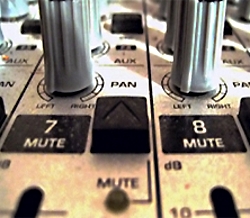
Let’s talk common mute mistakes
There are seven common mute mistakes:
1) Not muting unused open microphones. An open microphone that’s not being used can introduce noise and unwanted stage sounds into your mix. Also, in the right scenario, they can become the cause for feedback. Mute every unused open channel.
2) Muting instead of fading. Picture this, a soloist is singing to a recorded track. She stops singing and the track begins fading out. Suddenly, the music stops. “NEXT!“ That’s about how it comes across; “you’re done, I stopped the music, please exit the stage.” You are producing the whole service, so everything should flow together. Therefore, fade music all the way before you mute the channel.
3) Muting without fading. The best example of this is that you are playing the recorded track from #2 and you let the music fade naturally as per the recording. Then you mute the channel once the song is over. Fifteen seconds later, you hear something coming from the stage. You have muted the channel but the monitor is still active and the next track is now playing. Therefore, when playing media, remember it’s best to use both the mute and the fade in case you forget to hit the STOP button.
4) Un-muting with the volume up. The pastor starts talking and you’ve forgotten to un-mute his channel. Therefore, you un-mute it with the fader already at the nominal level. POW! His voice bursts through the air in a rather unpleasant fashion. [Unpleasant fashion? Where did I pull that phrase from?] Instead, move the fader down, un-mute the channel, and raise the fader up to the proper location. This one isn’t so much about not making a mute mistake but how to best recover from it.
5) Incorrect muting with mute groups. Going back to the mute group / VCA comments I made earlier in the article, depending on your setup, you may or may not be muting the monitor sends as well. Make sure you have your pre/post fader channel options selected correctly and test them by muting the group during rehearsal.
6) Unassigned mute group channels. Do you have the background singers in a mute group? Are you sure you have them all in a mute group? If not, one background singer will quickly become a soloist. Double-check your routings and settings regarding groups.
7) Missing a cue. You didn’t un-mute a channel in time. I almost didn’t list this one as it seems more about paying attention and less about the mute button…but when it comes to that lil’ ol’ mute button, it’s front and center. You need to bring your A-game each time you are behind the mixer. Do that and missing a cue won’t be a problem.
Summary
Mute mistakes are the biggest mixing issues the congregation notices during a service. One or two people might notice a mistake in the drum mix but when you miss a cue or jar them by suddenly muting an active channel, everyone will notice.
Chris Huff is a long-time practitioner of church sound and writes at Behind The Mixer, covering topics ranging from audio fundamentals to dealing with musicians – and everything in between.
